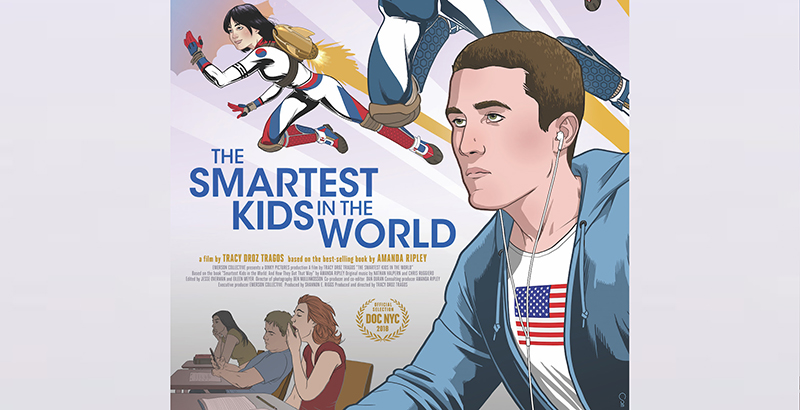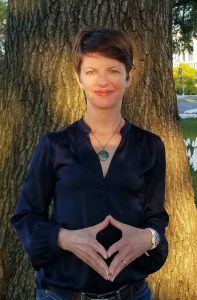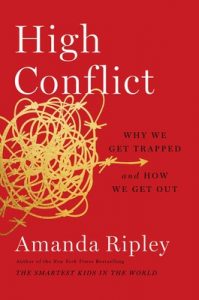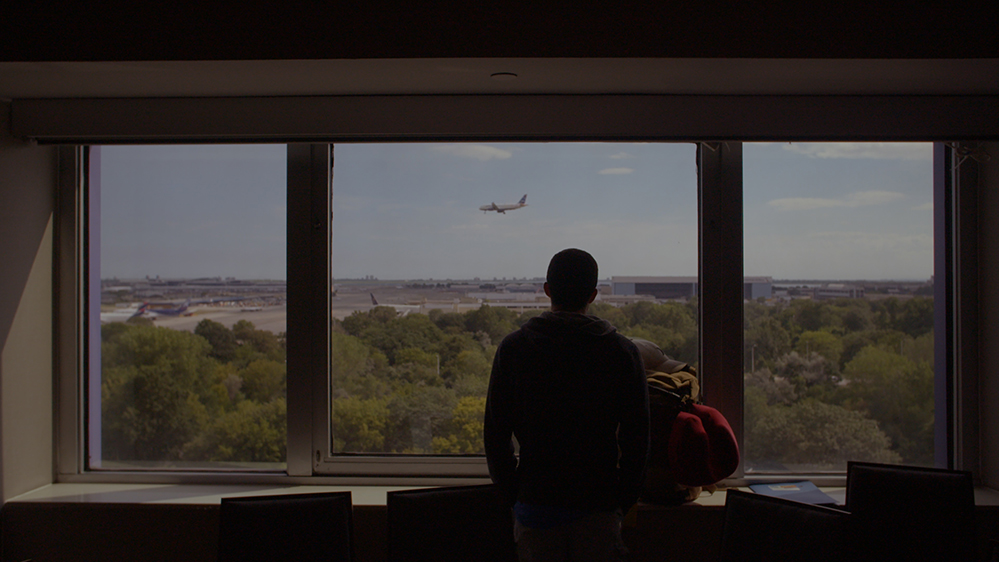The 74 Interview: Author Amanda Ripley on the Pandemic, Trust in American Education and the New Film About Why American Schools Aren’t the Best in the World

Get stories like this delivered straight to your inbox. Sign up for The 74 Newsletter
See previous 74 Interviews: Author Angela Duckworth on psychology and parenting, Rebecca Sibilia on school funding in the U.S., Isabel Sawhill on schools and American identity post-Trump, and John White on the New Orleans “experiment.” The full archive is here.
A decade ago, journalist Amanda Ripley wanted to answer a simple question: Why do international tests routinely show dozens of countries outperforming the United States academically?
Her resulting book, The Smartest Kids in the World, became a bestseller and one of the most talked-about releases in 2013. Following three American students as they traveled to high schools in South Korea, Finland, and Poland, Ripley attempted to shine a light on the deficiencies of the U.S. education system, from underprepared teachers in the classroom to an overemphasis on sports outside of it. Everything wasn’t perfect overseas — witness the obsessive preparations undertaken for the high-stakes Suneung test, the intensity of which has led the Korean government to crack down on “cram schools” — but they all seemed to have lessons for American educators to replicate.
This year, Ripley has published another high-profile book, High Conflict, about the perils of intractable social conflict. But she isn’t finished with schools: The Smartest Kids in the World has been adapted into a documentary, directed by Tracy Droz Tragos, which will premier Thursday on the streaming network Discovery Plus. Taking after its source material, the film tracks the experiences of four American teens studying for a year in Finland, Switzerland, South Korea, and the Netherlands. Their triumphs and setbacks — from overcoming huge language barriers to taking on far tougher coursework than they are accustomed to — bring the challenges of international education into human focus.
In a discussion with The 74’s Kevin Mahnken, Ripley talked about the “mediocre vibe” she has detected in American classrooms, the declining faith we feel in our institutions and one another, and the sequence of bitter arguments that have plagued education policy over the past year. And while the film doesn’t address the COVID-19 crisis, she has also noted that schools in some of the highest-achieving countries reopened much sooner than in the United States.
The interview was edited for length and clarity.
The 74: This film is an adaptation of your 2013 book, The Smartest Kids in the World, which basically explored the deficiencies in American education by looking at success stories in other countries. How has your assessment of the relative performance of American schools changed over the last eight years?
Amanda Ripley: A lot has happened, and a lot hasn’t happened. In some ways, we have seen even more vividly the weaknesses in our own system, and the levels of distrust in our system — our teachers, each other, our government. As we’re seeing, this has made everything we try to do so much harder, and obviously the pandemic really stripped that bare. The mediocrity in our test scores, particularly in math, has continued. The disparities have continued. And our preexisting conditions made the pandemic that much more painful for everyone, especially kids.
The wider question of social trust doesn’t really appear in the documentary, though it plays a significant role in the political conflicts you explore in your new book. It sounds like you’re saying that the declining trust Americans feel in their institutions, including schools, is making it more difficult to offer excellent public education.
Anything that’s hard to do and requires cooperation is going to be much harder in the U.S. until we fix this deep distrust we have for each other. There are clear reasons why this distrust exists and has for a long time. It’s true that my head is more focused now on conflict, but education was the original high conflict. For years and years and years, facts haven’t swayed people on education; it’s much more emotion. And that predates Trump.
There’s a lot we couldn’t put in the film, and it was really hard for Tracy and her team to decide what to keep and what to cut. But I think you pick up on it in the way that the students have more autonomy in most of the countries, and it’s something that comes up a lot when students come to the U.S. from other countries. They’re kind of taken aback by the amount of control that schools and families want to exert over their bodies, and where they are and what they do. The bathroom pass, which is mostly a U.S. phenomenon, is always a powerful symbol of this. So the more trust you have in kids, the more independence you typically let them have; in societies where there is more violence and more distrust, which have a high premium on compliance, it is harder for people to give up control over teenagers.
There’s a funny part in the documentary when an American student, Brittany, spends her first few weeks in Finland almost offended that students there can pretty much come and go as they please. At the same time, some would argue that our closed-off schools and ubiquitous hall passes just reflect the reality of how different American society is from those other countries, especially in terms of violence.
Just like our healthcare system or our higher education system, the elementary and secondary education system we have reflects the society we’ve built. There are good things about that, and there are really tragic things. It’s also very hard, when you’re in a system, to see it clearly. These students can see the water they swim in, which makes them so valuable: They can at least notice what it looks like when sports are not the main thing bringing joy to a school. They notice when they’re allowed to leave campus for lunch, or discreetly go to the bathroom without permission. They notice when a substitute teacher isn’t necessary because the students just keep working if a teacher is gone from one class.
Noticing all that is the first step. Changing it is hard, and in some places, we just continue to do what we’ve always done without questioning it. There are lots of schools in the United States — I mean, most schools — where kids are not likely to experience gun violence. So how much of this is in our heads and our history, and how much of it is reality? It’s a very important question to at least ask.
Another factor mentioned in the film is the fact that, by the time kids in some of these countries — Finland, Switzerland, the Netherlands — reach adolescence, they’ve usually undergone some form of sorting that places them into either academic or vocational tracks. Could the relative freedom and trust that prevails in these schools be accounted for by the fact that, as one Finnish student put it, they’ve “chosen” to be in school? And if so, is it a point in America’s favor that virtually all K-12 students are, at least ostensibly, on an academic track?
Well, if that were true, I’d say it’s great. I think that’s what we say, but in reality, you and I know that physics is only offered in two-thirds of schools serving high concentrations of students of color. Only 41 percent of 12th-graders have taken the full suite of biology-chemistry-physics. Forty-one percent! So we’re saying, “Everybody should be on a track to college.” But that’s not what happens.

Of course, it’s tricky to have this fork in the road where students can choose a more pre-professional track, unless you make it just as serious and rigorous [as the academic offerings]. So maybe it’s hopeful news that, today, to go into any meaningful vocational direction, you need rigorous math and reading and thinking. There is no such thing as a “jock track” if you want to succeed. The solution might be to let kids have a little more autonomy about which track they want to go on, but also make sure the standards and teaching quality are really good in both cases. I followed a student from Oklahoma to Finland, and the vocational school in her town was actually way more popular [for students there]. It was a constant struggle for the university-track high school to keep students, and there was this interesting sort of competition between the vocational and academic tracks. The vocational school had all this cool equipment and technology and connections to big companies, and that was exciting for a lot of students because it ended in a decent-paying job.
Did the American students in the film offer similar criticisms of schools in the U.S.?
There were definite themes, and the most interesting part is asking what they all noticed, what they missed, what they admired. Virtually all U.S. kids I’ve interviewed who have studied abroad in high-performing public high schools notice a few of the same things. There are differences depending on where they came from, but they notice the rigor of the schools they go to. In some places, it’s the quantity of the work, but in most places, it’s more about the quality. They notice that things are just more challenging, and there’s a lot they haven’t learned, particularly in math. You saw that with Jaxon [a student featured in the film who travelled from Wyoming to the Netherlands].
Most of them also notice that they got more homework in the U.S., though the ones who went to Korea are outliers. Most of them talk about having more independence from their schools and their host families. That all came out in surveys of hundreds of exchange students that I did for the book. There are also things they miss from their schools and homes in the U.S. Putting sports aside, the amount of extracurriculars that U.S. schools generally offer is pretty cool and atypical. Another theme was that their American teachers were more approachable — not in every case, but foreign students who came to the U.S. would talk about that in the survey. Depending on where you’re coming from, there can be less hierarchy in the U.S. and not as much need to conform.
And what teenagers care the most about is other kids; that’s way more impactful than teachers or host parents. What they noticed a lot was that other kids seemed very bought-in to school, but they weren’t rocket scientists. It’s not like kids in other countries are intrinsically smarter or funnier or more creative. They could tell that they were actually similar. The difference was the schools and peer culture they were in.
The film doesn’t address COVID, but I’m curious if you’ve kept up with the various pandemic responses in the countries you looked at, both in the book and the movie.
It’s hard to do these international comparisons because you can really cherry-pick your examples. But one of the painful realities the last year drove home was how different the pandemic experience was. In the Netherlands, schools closed down for about eight weeks. This was an equitable system of funding that predated the pandemic, as well as the world’s highest-rated broadband access. And still, in those eight weeks of closure, the students made essentially no progress in learning, and the effects were much worse for disadvantaged students. Whereas in the U.S., up to half of students had virtually no in-person instruction for the whole school year. I’m not going to suggest there’s just one reason for why the Netherlands didn’t close and the U.S. did, but you see it down the line: Finland closed for just a few months, Switzerland was about eight weeks.
All these countries struggled, but interestingly, the one that I think most paralleled the U.S. experience is South Korea, which had much more remote learning than those [European] countries. On the other hand, they have the world’s fastest internet speeds, so the challenges weren’t quite as great. And older high school students were allowed to return [to school buildings] in South Korea to prepare for that huge test we focus on in the movie. There’s a lot that came out in the pandemic that we still don’t understand, but in places where trust is high and instructional coaching is high-quality, I think it’s going to make a big difference. And trust is not high in either South Korea or the U.S.
Do you think the comparative experiences around COVID are linked to this question of institutional trust that you’ve identified? If people believed that vital skills and knowledge were being imparted in schools, it seems like they’d be more reluctant to keep them closed. But I’ve heard versions of an argument, sometimes made by educators, that the idea of learning loss is a myth, kids can learn about themselves at home, and the expectations we have of classroom learning are just arbitrary goalposts. It doesn’t bespeak a ton of faith in the system.
I think you articulated that better than I did. Before the pandemic, we did not treat rigorous education as a priority for all students in this country. There were exceptions, but in general, we didn’t treat education or teaching with the kind of urgency that they demand.
So what happens? First, children pick up on that; it’s a huge impact that’s really hard to measure, but in the movie, Jaxon noticed when schools in his district closed every Friday because too many students were leaving for sports events. Think about the message that sends. And when schools don’t re-open in person, or virtual learning is a joke — which it always is to some degree, especially for little kids — what message does that send? It sends a really loud and really demoralizing signal to kids and families about how important education is compared to restaurants or supermarkets or hospitals. That’s brutal, and it’s going to take a long time to recover from that deep, symbolic failure. It didn’t happen everywhere, and it’s not the fault of any one person or group. But it’s heartbreaking.
I want to get back to the phenomenon of high conflict, the subject of your latest book. All throughout 2021, education politics has hurtled from debates about in-person re-openings to trans athletes to the 1619 Project to mask mandates. Is there any historical precedent for this level of partisan and ideological antagonism?

It does feel like some districts are facing a superstorm of conflict, particularly in states where infections are high, vaccination rates are relatively low, and they’re banned from instituting mask mandates. What I’ve been telling school leaders who have reached out is, “This is not normal. This is high conflict.” It’s not new to education, but it’s spreading more deeply, as we saw with Common Core and testing and a lot of other things. Facts no longer matter at some point because the emotion of the conflict takes over. It’s about winning and fear of the other side.
High conflict is a type of conflict that is dysfunctional. In every high conflict, whether it’s a divorce or gang violence or politics, it’s almost always children who suffer the most. We’re seeing that now; the conflict takes on a life of its own, and it’s very hard to interrupt or resist as a school leader or a union leader or whatever your role is. There are a lot of heroic teachers and school leaders and families and politicians trying to repair this frayed social fabric we have. But again it’s especially hard in a country where there is deep distrust for institutions and news media and each other. Sorry, that’s not really a satisfying answer.

Do you think part of the problem with American schools, and the disappointment and distrust that seem to characterize our relationship to them, is related to the huge number of tasks we assign to them? We obviously attach a lot of importance to academics and testing, but we also view schools as venues for workforce training, civic preparation, social-emotional learning, and a bunch of other things. That’s not to say that the countries featured in this film aren’t asking schools to do a lot, but by comparison, they seem to do something really specific, really well.
The thing I notice the most coming back to the U.S. from these places is that there’s very little consensus on what matters most in American schools. Schools are pulled in all different directions by parents, by educators, by unions, and you just cannot excel in any complicated endeavor without focus. I think that’s one of the biggest problems because there’s always going to be trade-offs, and if you try to do 20 things, you might do them all poorly.
Every time I watch the film, it’s like a montage of wasted time and potential: The tyranny of the bells, the metal detectors, the bored kids, the phones — so many kids on their phones! — and sports being the only lifeblood of the school. This is not, like, undercover footage. They got permission to record there, and there’s still this mediocre vibe in a lot of classrooms. It’s just a huge waste of potential, and it partly comes from a lack of clarity about the mission.
Do you think smartphones should be banned from classrooms? There’s a great clip in the film where a South Korean student goes from classroom to classroom taking phones and placing them in a big case during the day.
Absolutely. I mean, this is pretty obvious. And more generally, the U.S. has always over-invested in classroom technology, and we have almost nothing to show from it when it comes to learning. Every country I visited spends less on technology than the U.S., but kids are learning more. So yeah, it would make sense to remove distractions from an already distracted school.
The experiences these kids have overseas are just incredible. Do you think all high schoolers should have the opportunity to study abroad?
Oh, I love this question. I [studied abroad] myself. Like a lot of these kids, I basically left in order to flee the scene. And I went to a really good high school so that’s mostly on me. But I ended up in France, which is a walk in the park compared to South Korea or Finland when you think about the language barrier.
It rocked my world because what you see is how big the world is, how complicated and beautiful it is, and how ambivalent people feel toward the United States. There’s so much of our cultural influence, and in other ways, people really disdain the U.S. Trying to process that is really mind-expanding. None of it is simple, but particularly for Americans, who are so geographically isolated, going somewhere else is really part of the basic survival skills for the modern world. The exchange programs we worked with to find these students have been unbelievably intrepid in staying open and operating in many countries. It’s a very scary time to send your child to another country, but even now, it’s worth doing.
Get stories like these delivered straight to your inbox. Sign up for The 74 Newsletter

;)
